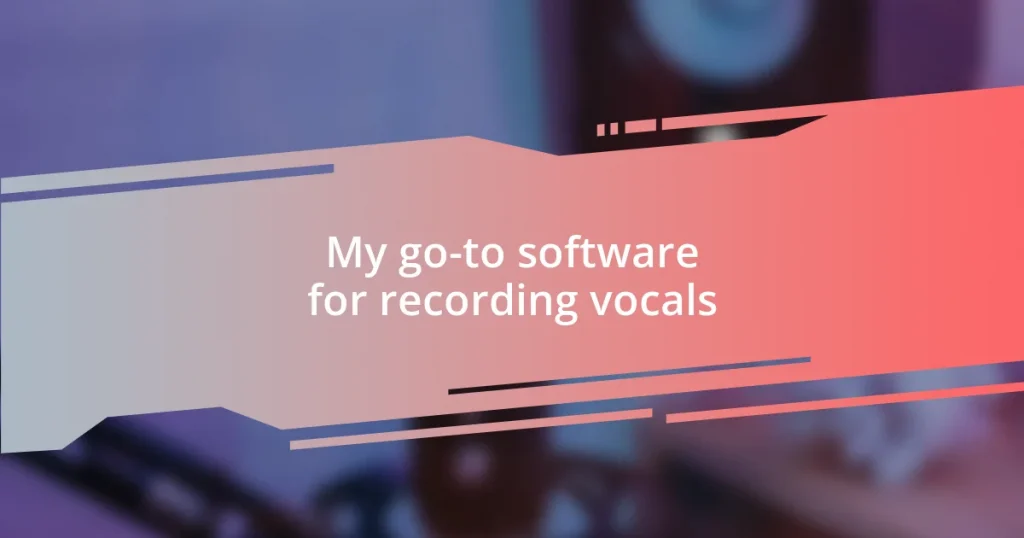Key takeaways:
- Choosing the right vocal recording software enhances creativity and allows for polished performances.
- Logic Pro X is favored for its intuitive interface and powerful features like Flex Pitch, while Ableton Live offers a unique, experimental workflow.
- Common recording issues include latency and background noise; solutions involve adjusting settings and optimizing recording environments.

Introduction to Vocal Recording Software
When I first dipped my toes into vocal recording, I had no idea how the software could transform my raw vocals into something polished and professional. It felt like entering a new world where creativity and technology intertwined, giving me the freedom to express myself in ways I had never imagined. Have you ever felt that rush of excitement when you hear your voice layered beautifully over an instrumental track? That’s the magic of vocal recording software.
Choosing the right software can be overwhelming, with so many options available that cater to different experience levels and needs. In my early days, I struggled to understand interfaces and features, often wondering if I would ever get the hang of it. But those moments of frustration were followed by sheer joy as I gradually discovered how to manipulate my recordings to capture the essence of my voice.
Investing time to learn about vocal recording software is truly rewarding. I remember spending countless hours experimenting with various tools, and each discovery felt like unlocking a new layer of my artistic potential. What’s more, the ability to tweak and refine my vocals means I’ve been able to evolve my sound over time, crafting it into something uniquely mine. How about you—are you ready to dive deeper into the world of vocal recording?

My Preferred Vocal Recording Software
When it comes to vocal recording, my top choice is actually a blend of functionality and user-friendliness. I can’t emphasize enough how important it is to have software that makes me feel inspired rather than overwhelmed. The moment I started using Logic Pro X, I felt an instant connection. Its powerful features, like Flex Pitch, allowed me to effortlessly fine-tune my vocal performances without detracting from the emotion I was trying to convey. There’s something truly satisfying about hearing my voice come to life, realizing that even minor tweaks can make a major impact on the final product.
Here’s a quick rundown of what I love about Logic Pro X:
- Intuitive interface: It makes navigation smooth, even when I’m diving into complex projects.
- Extensive plugin library: The variety helps me experiment with different sounds and effects.
- Flex Pitch: Perfect for correcting pitch issues while maintaining the vocal’s original character.
- Musical Typing feature: Enables me to use my keyboard as a MIDI controller whenever I want to add some instrumental texture.
I also find myself returning to Ableton Live for its unique workflow, especially when I’m in a more experimental mood. I vividly remember the first time I recorded a vocal loop and then built a whole track around it—it felt like painting with sound. The session was spontaneous, and the software’s capabilities allowed me to layer my vocals in real time, giving that organic feel to my music. It’s this blend of creativity and technology that keeps me excited about vocal recording.

Common Issues and Troubleshooting Tips
It’s not uncommon to encounter issues when recording vocals, but let me share a few troubleshooting tips from my experiences. One common problem is latency, which can throw off your timing. I remember recording a session where my voice was a split second behind the music—frustrating, to say the least! To resolve this, I learned to adjust the buffer size in my software settings, reducing the latency significantly. Have you ever tried tweaking the buffer size? It can make a world of difference.
Another challenge I often faced was background noise and interference. I remember one vocal take that had an annoying hum from my air conditioning unit. To combat this, I’ve developed a habit of recording in a quieter space and using sound isolation techniques, like blankets or foam panels, to minimize unwanted sounds. It’s amazing how much a bit of preparation can elevate the quality of your recordings!
Lastly, if you’re finding that your recordings just don’t sound right, it might be time to check your microphone placement. I’ve had moments where adjusting the mic just a few inches transformed the warmth of my vocals. Experimenting with angles and distances helped bring out the best in my sound. Are you ready to experiment with mic placement during your next session? You might just be surprised by the results!















